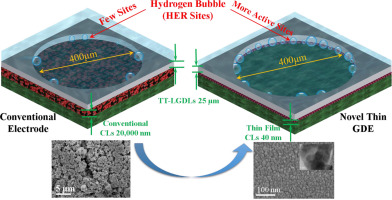Nano Energy ( IF 16.8 ) Pub Date : 2018-03-09 , DOI: 10.1016/j.nanoen.2018.03.015 Zhenye Kang , Gaoqiang Yang , Jingke Mo , Yifan Li , Shule Yu , David A. Cullen , Scott T. Retterer , Todd J. Toops , Guido Bender , Bryan S. Pivovar , Johney B. Green , Feng-Yuan Zhang

|
Proton exchange membrane electrolyzer cells (PEMECs) have received great attention for hydrogen/oxygen production due to their high efficiencies even at low-temperature operation. Because of the high cost of noble platinum-group metal (PGM) catalysts (Ir, Ru, Pt, etc.) that are widely used in water splitting, a PEMEC with low catalyst loadings and high catalyst utilizations is strongly desired for its wide commercialization. In this study, the ultrafast and multiscale hydrogen evolution reaction (HER) phenomena in an operating PEMEC is in-situ observed for the first time. The visualization results reveal that the HER and hydrogen bubble nucleation mainly occur on catalyst layers at the rim of the pores of the thin/tunable liquid/gas diffusion layers (TT-LGDLs). This indicates that the catalyst material of the conventional catalyst-coated membrane (CCM) that is located in the middle area of the LGDL pore is underutilized/inactive. Based on this discovery, a novel thin and tunable gas diffusion electrode (GDE) with a Pt catalyst thickness of 15 nm and a total thickness of about 25 µm has been proposed and developed by taking advantage of advanced micro/nano manufacturing. The novel thin GDEs are comprehensively characterized both ex-situ and in-situ, and exhibit excellent PEMEC performance. More importantly, they achieve catalyst mass activity of up to 58 times higher than conventional CCM at 1.6 V under the operating conditions of 80 °C and 1 atm. This study demonstrates a promising concept for PEMEC electrode development, and provides a direction of future catalyst designs and fabrications for electrochemical devices.
中文翻译:

具有超低催化剂载量的新型薄/可调气体扩散电极,用于质子交换膜电解池中的氢释放反应
质子交换膜电解槽(PEMEC)由于即使在低温操作下仍具有很高的效率,因此在制氢/制氧方面受到了极大的关注。由于广泛用于水分解的贵金属铂族金属(PGM)催化剂(Ir,Ru,Pt等)的高成本,迫切需要具有低催化剂负载量和高催化剂利用率的PEMEC,以实现广泛的商业化。在这项研究中,运行中的PEMEC中的超快速和多尺度氢析出反应(HER)现象是原位的第一次观察到。可视化结果表明,HER和氢气泡成核主要发生在薄/可调液/气扩散层(TT-LGDLs)孔边缘的催化剂层上。这表明位于LGDL孔中部的常规催化剂涂层膜(CCM)的催化剂材料未得到充分利用/失活。基于这一发现,已经提出并开发了一种新型的薄且可调谐的气体扩散电极(GDE),该电极具有15 nm的Pt催化剂厚度和约25 µm的总厚度,并利用先进的微米/纳米制造技术进行了开发。新颖的薄的GDE的全面表征两个易地和原位,并表现出出色的PEMEC性能。更重要的是,在80°C和1 atm的工作条件下,它们在1.6 V下达到的催化剂质量活性是传统CCM的58倍。这项研究证明了PEMEC电极开发的一个有前途的概念,并为电化学装置的未来催化剂设计和制造提供了方向。











































 京公网安备 11010802027423号
京公网安备 11010802027423号